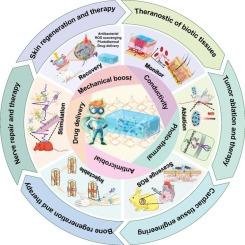Roles of MXene-integrated multifunctional hydrogels in tissue regeneration therapy: construction, mechanisms, and biomedical applications
IF 22
1区 材料科学
Q1 MATERIALS SCIENCE, MULTIDISCIPLINARY
引用次数: 0
Abstract
Regeneration engineering of tissue injuries or defects associated with diseases, such as infection and inflammation, is one of the key challenges facing clinical medicine. The development of innovative tissue engineering strategies offers great potential for overcoming the limitations in regenerating damaged tissues. The MXene, as an emerging representative of two-dimensional nanomaterials, with multifunctional properties particularly in unique aqueous dispersibility, excellent electrical conductivity, and abundant surface termination groups, has been harvesting extensive attention and investigation in the multi-modal nanoplatform of biomedical field. In this review, the outstanding performances of MXenes and progresses in MXene-integrated novel hydrogels for tissue regeneration therapy are systematically explored from the regeneration and therapy of skin to theranostic of biotic tissues. Firstly, the synthesis and surface modifications of MXene are summarized, and then their advantages are highlighted. Accompanied by the integration of MXene in the hydrogel, there are two methods for preparing MXene-based hydrogels with a profound understanding of the roles and MXene-induced new/enhanced performances with multi-modal responsiveness of hydrogels. Importantly, recent advancements of MXene-based hydrogels in tissue engineering are discussed in detail for expanding further exploration in biomedical applications. Moreover, the challenges and perspectives in integrated regenerative therapies by MXene-based hydrogels are highlighted, aiming to provide fundamentally important research directions and potentially insightful revelations for tissue regeneration therapy.

mxene集成多功能水凝胶在组织再生治疗中的作用:构建、机制和生物医学应用
感染和炎症等疾病相关组织损伤或缺陷的再生工程是临床医学面临的关键挑战之一。创新组织工程策略的发展为克服损伤组织再生的局限性提供了巨大的潜力。MXene作为一种新兴的二维纳米材料的代表,以其独特的水性分散性、优异的导电性和丰富的表面终止基团等多功能特性,在生物医学领域的多模态纳米平台上得到了广泛的关注和研究。本文从皮肤的再生和治疗到生物组织的治疗,系统地探讨了MXenes的优异性能和集成MXenes的新型组织再生水凝胶的研究进展。首先对MXene的合成和表面改性进行了综述,并重点介绍了MXene的优点。随着MXene在水凝胶中的整合,有两种方法可以制备基于MXene的水凝胶,这些方法对MXene的作用和MXene诱导的水凝胶的新/增强性能具有多模态响应性。重要的是,详细讨论了基于mxeni的水凝胶在组织工程中的最新进展,以进一步探索其在生物医学领域的应用。此外,本文还强调了基于mxeni的水凝胶在组织再生治疗中的挑战和前景,旨在为组织再生治疗提供重要的研究方向和潜在的深刻启示。
本文章由计算机程序翻译,如有差异,请以英文原文为准。
求助全文
约1分钟内获得全文
求助全文
来源期刊

Materials Today
工程技术-材料科学:综合
CiteScore
36.30
自引率
1.20%
发文量
237
审稿时长
23 days
期刊介绍:
Materials Today is the leading journal in the Materials Today family, focusing on the latest and most impactful work in the materials science community. With a reputation for excellence in news and reviews, the journal has now expanded its coverage to include original research and aims to be at the forefront of the field.
We welcome comprehensive articles, short communications, and review articles from established leaders in the rapidly evolving fields of materials science and related disciplines. We strive to provide authors with rigorous peer review, fast publication, and maximum exposure for their work. While we only accept the most significant manuscripts, our speedy evaluation process ensures that there are no unnecessary publication delays.
 求助内容:
求助内容: 应助结果提醒方式:
应助结果提醒方式:


